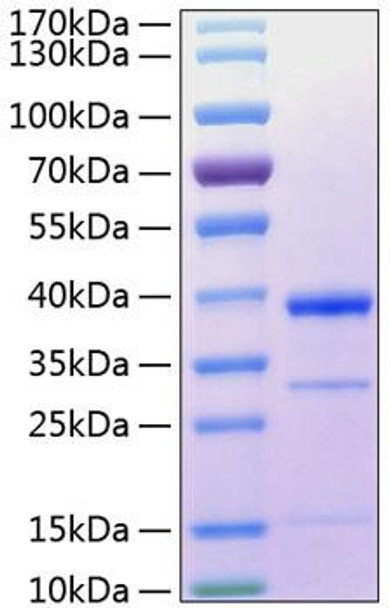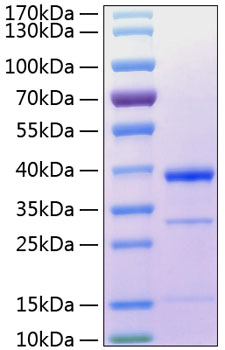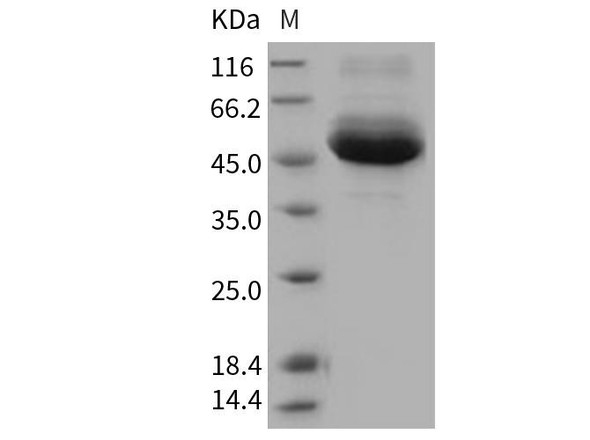Description
Recombinant Human Cathepsin S Protein
The Recombinant Human Cathepsin S Protein is a biologically active recombinant protein that plays a significant role in various cellular processes and signaling pathways in human biology. This protein is widely employed in immunological research, cell biology studies, protein-protein interaction analyses, and therapeutic development, providing researchers with a reliable tool for investigating Cathepsin S function and its implications in health and disease.
This product (SKU: RPCB0329) is produced using HEK293 cells and features a C-His tag for convenient detection and purification. The protein exhibits a calculated molecular weight of 36.66 kDa with an observed molecular weight of 37-40 kDa under denaturing conditions, achieving ≥ 95 % as determined by SDS-PAGE.. Functional bioactivity has been validated through rigorous quality control assays, confirming its suitability for demanding research applications.
Key Features
| High Purity by Affinity Chromatography | |
| Mammalian & Bacterial Expression Systems | |
| High lot-to-lot consistency via strict QC |
| Product Name: | Recombinant Human Cathepsin S Protein |
| SKU: | RPCB0329 |
| Size: | 10 μg , 20 μg , 50 μg , 100 μg |
| Reactivity: | Human |
| Synonyms: | CTSS |
| Tag: | C-His |
| Expression Host: | HEK293 cells |
| Calculated MW: | 36.66 kDa |
| Observed MW: | 37-40 kDa |
| Gene ID: | 1520 |
| Protein Description: | High quality, high purity and low endotoxin recombinant Recombinant Human Cathepsin S Protein (RPCB0329), tested reactivity in HEK293 cells and has been validated in SDS-PAGE.100% guaranteed. |
| Endotoxin: | < 0.1 EU/μg of the protein by LAL method. |
| Purity: | ≥ 95 % as determined by SDS-PAGE. |
| Formulation: | Lyophilized from a 0.22 μm filtered solution of 50mM MES,100mM NaCl, pH6.5.Contact us for customized product form or formulation. |
| Bio-Activity: | Measured by its ability to cleave the fluorogenic peptide substrate, Mca-RPKPVE-Nval-WRK(Dnp)-NH2. The specific activity is >1390 pmol/min/μg. |
| Reconstitution: | Centrifuge the vial before opening. Reconstitute to a concentration of 0.1-0.5 mg/mL in sterile distilled water. Avoid vortex or vigorously pipetting the protein. For long term storage, it is recommended to add a carrier protein or stablizer (e.g. 0.1% BSA, 5% HSA, 10% FBS or 5% Trehalose), and aliquot the reconstituted protein solution to minimize free-thaw cycles. |
| Storage: | Store at -20℃.Store the lyophilized protein at -20℃ to -80 ℃ up to 1 year from the date of receipt. After reconstitution, the protein solution is stable at -20℃ for 3 months, at 2-8℃ for up to 1 week. |
Cathepsin S (CTSS), one of the lysosomal proteinases, has many important physiological functions in the nervous system, especially in process of extracellular matrix degradation and endocellular antigen presentation. Cathepsin S is expressed in the lysosome of antigen presenting cells, primarily dendritic cells, B-cells and macrophages. Cathepsin S is most well known for its critical function in the proteolytic digestion of the invariant chain chaperone molecules, thus controlling antigen presentation to CD4+ T-cells by major histocompatibility complex (MHC) class II molecules or to NK1.1+ T-cells via CD1 molecules. Cathepsin S also appears to participate in direct processing of exogenous antigens for presentation by MHC class II to CD4+ T-cells, or in cross-presentation by MHC class I molecules to CD8+ T-cells. In addition, it has been implicated in the pathogenesis of several diseases such as Alzheimer’s disease and degenerative disorders associated with the cells of the mononuclear phagocytic system.







